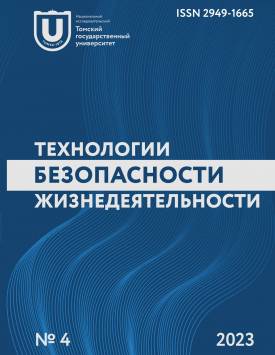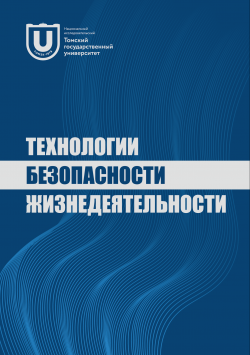Development of chemical and analytical instrumentation for detecting traces of explosives
A brief review of the development of the chemical and physical foundations of portable analytical instrumentation for detecting traces of explosives is given. Elementary processes in sampling methods are considered, including gas-chromatographic separation of detectable substances, ionization detection, express vapor concentration, remote vortex sampling of vapor from the surface of controlled objects. Multicapillary separation columns (MCCs) containing 1000 capillaries with a diameter of 40 pm were created for the first time for gas chromatographic separation of vapors of detectable substances. Rapid mass transfer in small-diameter capillaries provides high separation efficiency at small column lengths, which reduces the analysis time to 1020 s. Also, it provides a decrease in the separation temperature by about 50 ... 70 ° and the possibility of an isothermal separation mode, which sharply reduces the power consumption of portable devices. New methods of ionization detection of substances have been invented: ion mobility increment spectrometry (IMIS) and ionization detection of tunable selectivity (IDTS). IMIS provides highly sensitive detection of trinitrotoluene (TNT) vapor concentrations up to 10-14 g/cm3 without the use of chromatography. The use of UV laser ionization provides low detection thresholds for vapors of low-volatile explosives: RDX - 5,9 x 10-16 g/cm3, pentaerythritol tetranitrate 9,8 x 10-15 g/cm3. IDTS ensures the operation of a gas chromatographic multicapillary detector of explosive vapors with atmospheric air as a carrier gas, which is convenient when working in the field conditions. The air is purified by a miniature filter built into the detector. The use of a selective IMIS detector in a gas chromatographic detector provides a lowering of the threshold for detecting the concentration of TNT vapors to 10-16 g/cm3. Such a threshold sensitivity for TNT is two orders of magnitude better than that existing in the practice of antiterrorist control. It is shown that such a threshold sensitivity sharply reduces the time of detection of 200 g of TNT in baggage from the moment of putting it in baggage: from several days to 5 minutes. As a result, it was noted that today in the practice of anti-terrorist control portable devices with a detection threshold of explosive vapor concentration of 10-14 g/cm3 are used, in scientific research the thresholds reach 10-16 g/cm3. Sampling technologies are used exclusively. On the surface of controlled objects, there may be micro-quantities of explosives with a surface density of hundreds of ng/cm2. For modern detectors, the characteristic threshold sensitivity by mass in a sample, for example, by TNT, is 10100 pg; therefore, contact sampling of microparticles from the surface of objects began to be used, which increases the efficiency of trace detection, but reduces the speed of control. In order to increase the speed of effective vapor control, devices with a threshold of 10-16 g/cm3 are needed; research and work is being carried out in this direction. the author expresses his sincere gratitude to I.I. Zasypkina for help in the preparation of the article. The author declares no conflicts of interests.
Keywords
traces of explosives,
trace detection,
analytical scheme of detectors,
ionization detectors,
ultra-low detection thresholdAuthors
| Gruznov Vladimir M. | Trofimuk Institute of Petroleum Geology and Geophysics of the Siberian Branch of the Russian Academy of Sciences; Novosibirsk State University | GruznovVM@ipgg.sbras.ru |
Всего: 1
References
Washington W.D., Midkiff C.R. Jr. Systematic Approach to the Detection of Explossive Residues. II. Trace Vapor Analysis // Journal of the AOAC. 1973. Vol. 56 (5) P. 1239-1245.
Livesey R. Explosives Detection // Electronics & Power. 1984. Vol. 30 (9). P. 701.
Грузнов В.М. Обнаружение взрывчатых веществ (современное состояние) // Вопросы оборонной техники. Серия 16. Технические средства противодействия терроризму. 2014. Т. 3-4 (69-70). С. 94-99.
Грузнов В.М., Балдин М.Н., Макась А.Л., Титов Б.Г. Развитие в России методов обнаружения взрывчатых веществ // Журнал аналитической химии. 2011. Т. 66, № 11. С. 1236-1246.
А.с. 968181 СССР, МКИ G01N30/02. Хроматографическая колонка / Солдатов В.П., Овечкин А.И., Сидельников В.Н., Малахов В.В., Кузнецов В.В., Емельянова Л.Я., Уткин В.А., Емельянова О.А. (СССР). № 295508/25; заявл. 21.05.1980; опубл. 15.08.1991, Бюл. № 30.
А.с. 1651200 СССР, МКИ G01N30/56. Поликапиллярная хроматографическая колонка / Солдатов В.П., Науменко И.И., Ефименко А.П., Чертилина Л.Н., Ваганов В.С. (СССР). № 4172415, заявл. 04.12.1986; опубл. 23.05.1991, Бюл. № 19.
Ефименко А.П, Науменко И.И., Соболева В.К. Эффективность поликапиллярных колонок // Журнал физической химии. 2007. Т. 81, № 3. С. 488-492.
А.с. SU 966583 A1 СССР. Способ анализа примесей в газах / Горшков М.П. (СССР). № 2928359, заявл. 10.03.1980; опубл. 15.10.1982, Бюл. № 38.
Buryakov I.A. Ion current amplitude and resolution of ion mobility increment spectrometer (IMIS) // International Journal for Ion Mobility Spectrometry. 2001. Vol. 4 (2). P. 112-116.
Балдин М.Н., Грузнов В.М. Портативный газовый хроматограф с воздухом в качестве газа-носителя для определения следов взрывчатых веществ // Журнал аналитической химии. 2013. Т. 68, № 11. С. 1117-1122.
Буряков И.А. История спектрометрии приращения ионной подвижности // Журнал аналитической химии. 2018. Т. 73, № 12. С. 941-948.
Буряков И.А. Явления переноса ионов в газе в электрическом поле. Спектрометрия приращения ионной подвижности : дис.. д-ра физ.-мат. наук. Новосибирск, 2005. 190 с.
Zalewska A., Pawlowski W., Tomaszewski W. Limits of detection of explosives as determined with IMS and field asymmetric IMS vapour detectors // Forensic Science International. 2013. Vol. 226. P. 168-172. doi: 10.1016/j.forsciint.2013.01.005.
Буряков И.А., Коломиец Ю.Н., Луппу В.Б. Спектрометр нелинейности дрейфа ионов // Пат.RU 2178929 C2; заявка 2000101916/09 от 25.01.2000. Опубл. 27.01.2002.
Буряков И.А., Крылов Е.В., Солдатов В.П. Приборы и методы газового электрофореза. В кн. Химический анализ объектов окружающей среды / под ред. В.В. Малахова. Новосибирск : Наука, 1991. C. 113-127.
Буряков И.А., Коломиец Ю.Н. Экспресс-определение взрывчатых и наркотических веществ с помощью поликапиллярной газохроматографической колонки и спектрометра ионной подвижности // Журнал аналитической химии. 2003. Т. 58, № 10. С. 1057.
Breath Analysis Products // Owlstone Medical. 2009. URL: https://www.owlstonemedical.com/products/lonestar/(дата обращения: 15.01.2020).
A Canadian company called Cannabix is working on a cannabis-detecting breathalyzer machine // Quartz. 2015. URL: https://qz.com/453650/a-canadian-company-called-cannabix-is-working-on-a-cannabis-detecting-breathalyzer-machine/(дата обращения: 21.11.2019).
Kostarev V.A., Kotkovskii G.E., Chistyakov A.A., Akmalov A.E. Detection of explosives in vapor phase by field asymmetric ion mobility spectrometry with dopant-assisted laser ionization // Talanta. 2022. Vol. 245. P. 1-14. doi: 10.1016/j.talanta.2022.123414.
Костарев В.А. Влияние параметров лазерного излучения на образование ионов нитросоединений в лазерной УФ спектрометрии ионной подвижности : дис.. канд. физ.-мат. наук. М., 2022. С. 111, 132.
Балдин М.Н. Разработка портативного экспрессного хроматографа с воздухом в качестве газа-носителя для определения следовых количеств органических веществ на месте взятия пробы : дис.. канд. техн. наук. Томск ; Новосибирск, 2014. С. 2648.
Грузнов В.М., Филоненко В.Г., Шишмарев А.Т. Отбор и ввод проб при скоростном газохроматографическом обнаружении паров органических веществ // Журнал аналитической химии. 1999. Т. 54, № 11. С. 1134-1139.
Грузнов В.М., Филоненко В.Г., Шишмарев А. Т. Экспрессное улавливание паров веществ из воздуха // Теплофизика и аэромеханика. 2000. Т. 7, № 4. С. 617-620.
Грузное В.М., Филоненко В.Г. Скоростное концентрирование и вихревой отбор проб воздуха при обнаружении следовых количеств органических веществ. Новосибирск : ИНГГ СО РАН, 2011. С. 13-14.
Пилот-М - портативный обнаружитель (детектор) паров взрывчатых веществ. URL: https://www.lavandau.ru/katalog/explosive-detector/8-pilot-m.html (дата обращения: 15.01.2023).
Детектор паров ВВ МО-2М, МО-2Р. URL: http://www.sibel.info/ru/explosives-detectors/mo-2m.html (дата обращения: 18.01.2023).
Солдатов В.П., Кузнецов В.В., Морозов А. А. и др. Метод обнаружения низколетучих веществ // А.С. № 969089. СССР. 1981.
Грузное В.М., Балдин М.Н., Прямов М.В., Максимов Е.М. Определение концентрации паров взрывчатых веществ с дистанционным автоматизированным отбором проб при контроле объектов // Журнал аналитической химии. 2017. Т. 72, № 11. С. 1000-1005.

